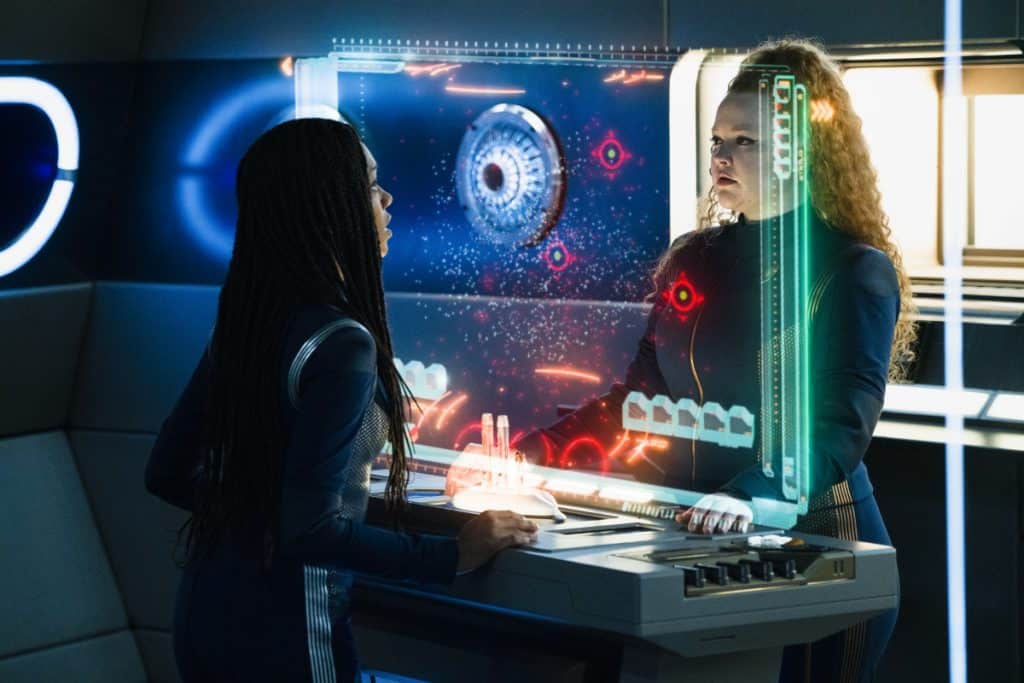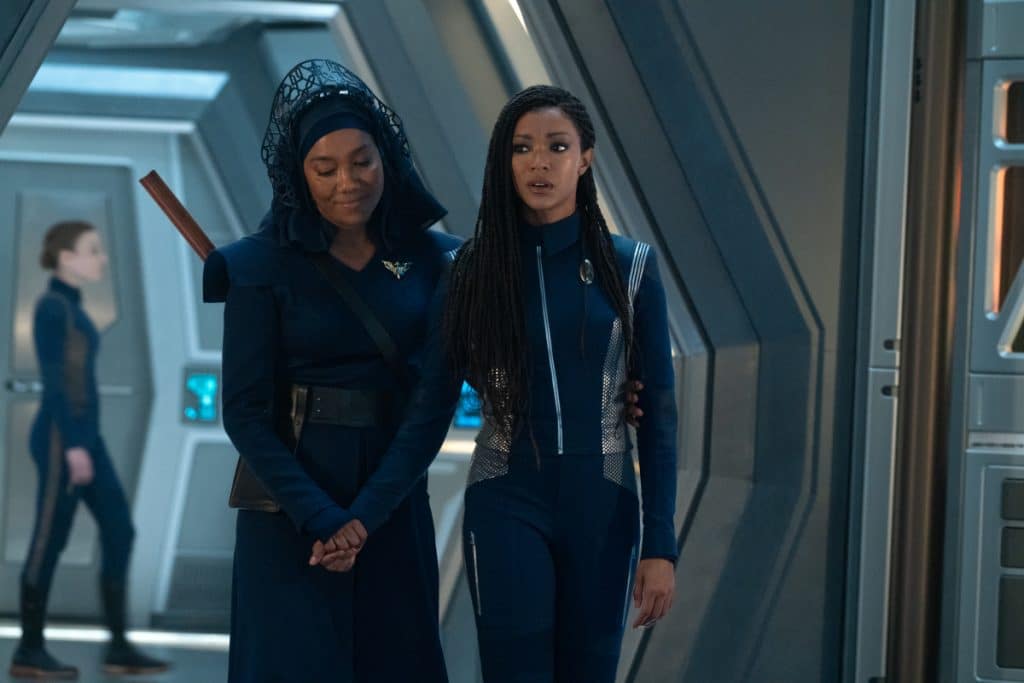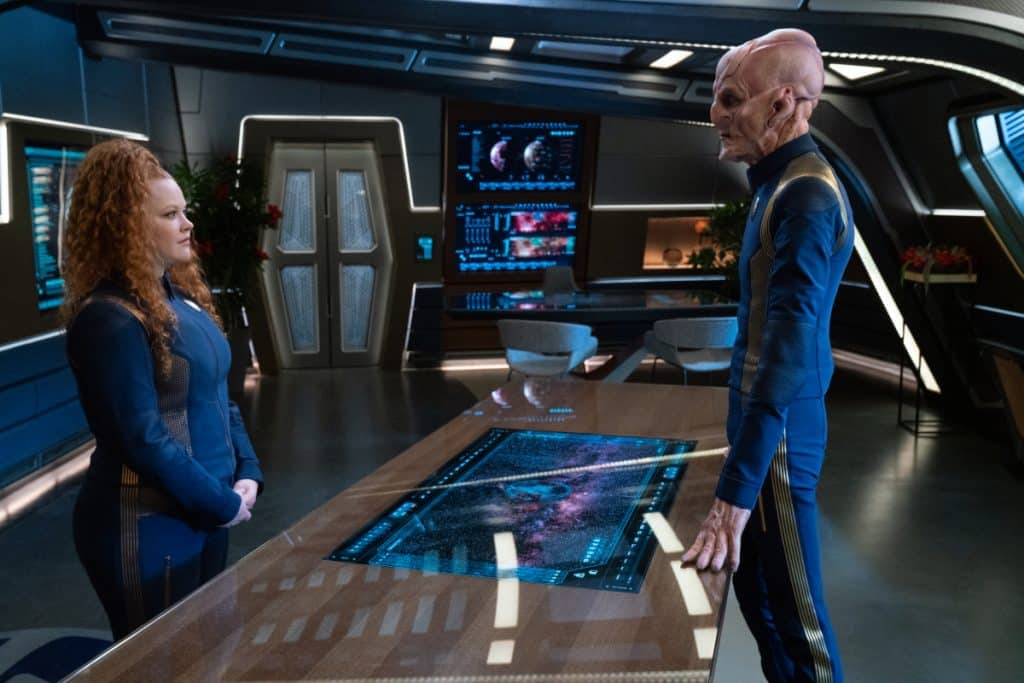Read also:
How to Watch FX Live Without CableHow To Watch AMC Without CableHow to Watch ABC Without CableHow to Watch Paramount Network Without CableMichael Burnham finally figures out who she is, as the Vulcans and Romulans return to the Star Trek fold.
The title “Unification III” is a bit cheeky. It winks at the audience, hinting that this is, in fact, the long-gestating sequel to a 1991 two-parter from Star Trek: The Next Generation that shares the same name. That episode featured a much-anticipated guest spot from Leonard Nimoy (there to promote Star Trek VI) as the famed Mr. Spock, a man striving to achieve peace and reconciliation between Vulcans and Romulans.
This episode of Discovery, released nearly thirty years later, is thankfully more of a spiritual successor than a direct sequel. It does feature a fair amount of fan service, including a clip of its TNG forebear and the series’ first name-drop of Jean-Luc Picard. But the episode itself is about more than just feting pasting adventures. It’s about the long-borne fruits of labors past. It’s about Michael Burnham’s (Sonequa Martin-Green) embrace of her multiple family legacies. And most of all, it’s about whether the needs of the many still outweigh the needs of the few.
That fundamental question drives “Unification III” on multiple levels. It extends to the fragile union between Romulans and Vulcans in the 31st century. These two “tribes” have renamed their shared home planet “Ni’Var” as a show of unity. But the tenuous peace between them is subject to internecine conflicts among the individual groups within that framework, each ready to pursue their own interests instead of promoting the common good while accusing the other side of doing the same.

It also connects to the reveal that Ni’Var and its people have long since abandoned the Federation, partly out of a sense that the interplanetary government asked too much of its individual members in favor of the welfare of the whole, stretching some too thin. And most of all, these ideas touch Burnham herself, who’s nearly reached a breaking point over whether the person she’s become as an individual over the past year can still fit with the person she needs to be as a Starfleet officer, one expected to serve an institution bigger than herself.
“Unification III” benefits from grounding all of that highfalutin philosophizing and navel-gazing within a more straightforward story focused on clear objectives. Having recovered Book’s (David Ajala) black box, Burnham and Tilly (Mary Wiseman) discover evidence that The Burn has a specific source, one they can’t locate without more information. Unfortunately, that info is in the possession of the people of Ni’Var, who seem unlikely to be forthcoming.
It turns out the Vulcan/Romulan alliance broke with the Federation over a project called SB19, undertaken to find an alternative to dilithium-based faster-than-light travel. The Federation pushed Ni’Var to continue that research despite warnings of instability, and the project soon became controversial among Vulcans and Romulans, with many believing the experiment itself caused The Burn. With diplomatic ties frayed, the data Burnham needs rests in the possession of a group that wants nothing to do with Starfleet, and for whom SB19 is a sensitive subject, to say the least.
Thankfully, the Federation has an ace up its sleeve — Burnham herself, who can lay claim to being the sister of Spock, the legendary architect behind the Unification, with the hope it might be enough to persuade Ni’Var’s president to share this information. It’s a nice way for Discovery to invoke Burnham’s personal history and Star Trek’s history at the same time.
“Unification III” benefits from grounding all of that highfalutin philosophizing and navel-gazing within a more straightforward story focused on clear objectives.
When speaking with the Vulcan President, Burnham adopts her more formal bearing, the one she often assumed in the presence of Sarek, reflecting her connection to Vulcan society. She tearfully watches a video of her brother as a grown man, seeing the great thinker and diplomat he would one day become. While Discovery handled Burnham’s connection to the Spock family and past Trek clumsily from the beginning, there’s legitimate meaning and earned sentiment when the show invokes both here.
Despite that fraternal door-opening, Burnham still faces resistance from the people of N’Var. Eventually, she has to invoke an Ancient Vulcan Thesis Defense ritual to be able to make her case for why she and the Federation should be granted access to the data she so sorely wants. That gives Discovery the opportunity to do a good ol’ fashioned Star Trek tribunal, one adjudicated by a “Romulans First” judge, a Vulcan purist judge, and a centrist judge, the three of whom can’t agree on much of anything.
It also provides the show with an excuse to bring back Michael’s mother, Gabrielle Burnham (Sonja Sohn) and reunite her with her daughter. It’s the one major choice in “Unification III” that doesn’t fully work. As heartening as it is to see Michael finally find her mom in the future, Gabrielle’s out-of-nowhere inclusion in what seems like an unrelated storyline scans as contrived.
To the point, in the intervening years since her arrival in the far future, Gabrielle has joined the Qowat Milat, an order of Romulan warrior nuns introduced in Star Trek: Picard who believe in “absolute candor.” That conveniently situates her to act as Michael’s advocate during the quasi-court proceedings. The choice makes more emotional sense than…well…literal sense, especially when the Burnhams’ reunion is brief and given a “We’ll check back on this later” tag at the end of the episode.

Gabrielle is, nevertheless, the key to Michael achieving her goal here. It may not seem that way at first, however, to Michael or to the audience. With Ni’Var’s judges questioning Michael’s logic and needling one another in the process, Gabrielle embraces her order’s frank precepts and publicly questions both her daughter’s motives and credibility. Far from strengthening Michael’s standing with the people of Ni’Var, Gabrielle appears to be undermining it.
But it soon becomes clear that Gabrielle is simply using a Vulcan/Romulan equivalent to the Socratic Method (the Surak Method?) to lead her daughter to the personal realizations necessary to succeed in her professional objectives. Pointed challenges over why Michael agreed to this mission in the first place after mutinying on multiple occasions, and why she still believes in the Federation after all she’s seen and done, prompt Michael to realize that what she values is the institution’s commitment to a greater good. That honest realization sways her to stay on Discovery despite her former reservations and resolves (temporarily at least) the uncertainty she’s grappled with since rejoining the crew.
It also leads her to an unorthodox solution to the issue before the tribunal. In the end, she withdraws her formal request for the data and ends the inquiry herself, after seeing how the proceedings are tearing this already-fractious community apart. She recognizes that Spock, for all his devotion to scientific discovery, wouldn’t want so fragile a peace to be disturbed, even to get to the bottom of one of the galaxy’s great mysteries.
Her gesture serves as an affirmation of that grander purpose — toward preserving communities, fostering cooperation, and promoting the general welfare over one’s individual needs. More than that, it persuades the President of Ni’Var to give Michael the data on her own, having witnessed how Michael’s selflessness and devotion to the principles of Spock and those of Star Trek more broadly prove her worthiness to receive it. Those principles live on in Michael and the Federation, offering hope for a brighter future.

The truth is that despite its communal bent, Star Trek has always prized a certain sense of rugged individualism, from Kirk’s cowboy diplomacy to scores of stories that march to the tune of “Damn our orders and Starfleet protocols; we’ve got to do what’s right!” But the franchise has also always championed a seemingly paradoxical but no less potent sense of collective good.
Buried within the very premise of The Original Series was the notion that people of different backgrounds and beliefs could come together for the welfare of all. Inherent in the idea of the Federation is the notion that diverse and distinctive communities can achieve great things and uphold worthy ideals when they work together in service of broader goals to benefit everyone.
Intrinsic to Burnham’s epiphany here is an effort to honor both parts of that ethos, to recognize that she and those like her are individuals, who can still have relationships and principles and joys all their own. But those individuals can also be a part of something greater than themselves, that connects them to their vaunted siblings, their time-displaced parents, and the friends and colleagues who make up precious communities and traditions that stretch across space and time.
As we embark on a holiday season where, more and more, it feels like the needs of the many succumb to the needs of the few, it’s inspiring to see Burnham thread that needle and affirm Star Trek’s devotion to the greater good: for the Federation, for the community that raised her, and for herself.
Ensign’s Log:
- A warmhearted B-story sees Tilly earn a promotion to acting First Officer while Saru (Doug Jones) looks for a more permanent replacement. It’s a nice win for Tilly. Her personal insecurities, counterbalanced by a rousing show of support from her friends and (technically) her superiors, make for a nice counterpoint to Burnham’s story, showing someone else finding their place and their home on Discovery despite their doubts.
- Saru continues to cut the figure of a laudably different sort of Starfleet captain than the type we’re used to. He’s more explicitly empathetic and encouraging in his approach and demeanor, whether he’s showing confidence in Tilly or finding common ground with N’Var’s President.
- Speaking of which, lord knows there’s already enough romance on this show. But hey, if Saru and the Vulcan President decided to go on a few dates together (purely in the interest of diplomacy, of course) I wouldn’t complain.
- As we hit the halfway mark on the new season, the programmable matter has clearly become the defining aesthetic of the 31st century. Watching Admiral Vance (Oded Fehr) walk across a slowly expanding walkway Magneto-style remains a trip.
- Nearly all of the continuity nods in “Unification III” are well-done and subtle enough to work, but Burnham noting that Spock would find all of this “fascinating” is a little too cute.
- The quick look of contentment on Lt. Stamets’s (Anthony Rapp) face when he gets to bury his hands in jello rather than having the Spore Drive controls jammed into his shunts is a nice touch.
- It could be nothing, but an off-hand comment suggests that the titular Unification efforts also include the Remans, a subjugated caste introduced in everyone’s favorite film — Star Trek: Nemesis. Alas, there’s no weepy flashback clip for Shinzon in this one.